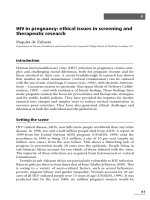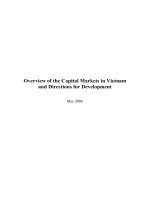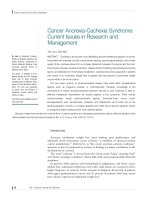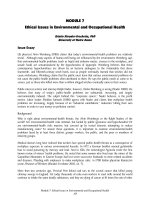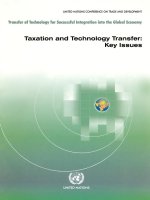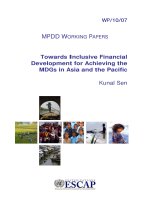Critical issues in taxation and development
Bạn đang xem bản rút gọn của tài liệu. Xem và tải ngay bản đầy đủ của tài liệu tại đây (3.17 MB, 252 trang )
Critical Issues in Taxation and Development
CESifo Seminar Series
edited by Hans-Werner Sinn
Economics and Psychology: A Promising New Field Bruno S. Frey and Alois Stutzer,
editors
Institutions and Norms in Economic Development Mark Gradstein and Kai A.
Konrad, editors
Pension Strategies in Europe and the United States Robert Fenge, Georges de
Ménil, and Pierre Pestieau, editors
Foreign Direct Investment and the Multinational Enterprise Steven Brakman and
Harry Garretsen, editors
Sustainability of Public Debt Reinhard Neck and Jan-Egbert Sturm, editors
The Design of Climate Policy Roger Guesnerie and Henry Tulkens, editors
Poverty, Inequality, and Policy in Latin America Stephan Klasen and Felicitas
Nowak-Lehmann, editors
Guns and Butter: The Economic Laws and Consequences of Conflict Gregory D.
Hess, editor
Institutional Microeconomics of Development Timothy Besley and Rajshri Jayaraman, editors
Dimensions of Competitiveness Paul DeGrauwe, editor
Reforming Rules and Regulations Vivek Ghosal, editor
Fertility and Public Policy Noriyuki Takayama and Martin Werding, editors
Perspectives on the Performance of the Continental Economies Edmund S. Phelps
and Hans-Werner Sinn, editors
Industrial Policy for National Champions Oliver Falck, Christian Gollier, and
Ludger Woessmann, editors
Illicit Trade and the Global Economy Cláudia Costa Storti and Paul De Grauwe,
editors
The Continuing Evolution of Europe Thiess Buettner and Wolfgang Ochel, editors
The Evolving Role of China in the Global Economy Yin-Wong Cheung and Jakob
de Haan, editors
Critical Issues in Taxation and Development Clemens Fuest and George R. Zodrow,
editors
A list of the entire series is available at .
Critical Issues in Taxation and Development
edited by Clemens Fuest and George R. Zodrow
The MIT Press
Cambridge, Massachusetts
London, England
© 2013 Massachusetts Institute of Technology
All rights reserved. No part of this book may be reproduced in any form by any electronic
or mechanical means (including photocopying, recording, or information storage and
retrieval) without permission in writing from the publisher.
MIT Press books may be purchased at special quantity discounts for business or sales
promotional use. For information, please email or write
to Special Sales Department, The MIT Press, 55 Hayward Street, Cambridge, MA 02142.
Set in Palatino by Toppan Best-set Premedia Limited. Printed and bound in the United
States of America.
Library of Congress Cataloging-in-Publication Data
Critical issues in taxation and development / edited by Clemens Fuest and George R.
Zodrow.
p. cm — (CESifo seminar series)
Includes bibliographical references and index.
ISBN 978-0-262-01897-5 (hbk. : alk. paper) 1. Taxation—Developing countries. 2. Tax
evasion—Developing countries. 3. Economic development—Developing countries. I.
Fuest, Clemens, 1968– II. Zodrow, George R.
HJ2319.C75 2013
336.200912'4—dc23
2012036427
10
9
8
7
6
5
4
3
2
1
Contents
Series Foreword
vii
I
1
Introduction 3
Clemens Fuest and George R. Zodrow
2
Taxation and Development—Again
Michael Keen
13
II
3
Do Companies View Bribes as a Tax? Evidence on the Tradeoff
between Corporate Taxes and Corruption in the Location of
FDI 45
Timothy Goodspeed, Jorge Martinez-Vazquez, and Li Zhang
4
Do Corruption and Taxation Affect Corporate Investment in
Developing Countries? 65
Clemens Fuest, Giorgia Maffini, and Nadine Riedel
5
Investment Treaties and Hydrocarbon Taxation in Developing
Countries 83
Johannes Stroebel and Arthur van Benthem
III
6
The Effect of a Low Corporate Tax Rate on Payroll Tax
Evasion 109
Boryana Madzharova
vi
Contents
7
International Profit Shifting and Multinational Firms in
Developing Countries 145
Clemens Fuest, Shafik Hebous, and Nadine Riedel
8
Too Low to Be True: The Use of Minimum Thresholds to Fight
Tax Evasion 167
Mirco Tonin
IV
9
Fiscal Federalism and Foreign Transfers: Does
Interjurisdictional Competition Increase the Effectiveness of
Foreign Aid? 189
Christian Lessmann and Gunther Markwardt
10
Taxation and Democracy in Developing Countries 217
Paola Profeta, Riccardo Puglisi, and Simona Scabrosetti
List of Contributors
Index 241
239
Series Foreword
The CESifo Seminar Series aims to cover topical policy issues in economics from a largely European perspective. The books in the series
are products of papers and intensive debates that took place during
the seminars hosted by CESifo, an international research network of
renowned economists organized jointly by the Center for Economic
Studies at the Ludwig-Maximilians-Universität and the Ifo Institute for
Economic Research. The publications in this series have been carefully
selected and refereed by members of the CESifo research network.
I
1
Introduction
Clemens Fuest and George R. Zodrow
The ability of governments to raise taxes in order to finance public
goods is essential to achieving economic development and growth.
Many developing countries find it very difficult to raise the revenue
required to provide basic public services such as infrastructure or
schools. Improving the revenue-raising capacity of the public sector
without crippling the growth prospects of a developing economy is
a difficult policy challenge. Moreover, many of the central themes of
ongoing debates regarding tax reform in developing countries—such
as the mix of direct and indirect taxation and the details of the tax rates
and tax base under the income tax—are less important in a developing
country, where issues such as dealing with widespread corruption,
erosion of the tax base due to evasion and avoidance (including the
pervasive phenomenon of income shifting by multinational corporations), the importance of resource taxes (and their variability due to
often dramatic fluctuations in the prices of resources), and ineffective
political structures dominate discussions of tax reform. This volume
brings together nine studies in which leading researchers in the field
investigate various aspects of the challenge of effectively raising tax
revenue in developing countries, focusing on specific issues that are
highly relevant to reforms of their tax structures. Earlier versions of
these studies were presented and discussed at the conference on Taxation in Developing Countries held during the CESifo Venice Summer
Institute at the Venice International University in July of 2010.
In particular, this book takes a unique approach to the difficult issue
of raising revenue in developing countries. The approach falls somewhere between an overarching treatment of virtually all tax issues
facing developing countries and all types of taxes (as in Bird and
Oldman 1990 or Alm, Martinez-Vazquez, and Rider 2006) and the treatments found in volumes that are either tax-specific (e.g., Bird and
4
Fuest and Zodrow
Gendron 2007; Ebrill, Keen, Bodin, and Summers 2001; Daniel, Keen,
and McPherson 2010) or country-specific (e.g., Thirsk 1997; Gordon
2010). Instead, apart from Michael Keen’s comprehensive and insightful overview of current issues in taxation and development in chapter
2, each chapter in this book focuses on one fairly narrowly defined
issue that is a critical element of a complete understanding of the effects
of taxes on development, and uses modern empirical methods to comprehensively address that issue. A wide variety of topics are covered
in this context, including various ways in which business taxation
affects development; corruption, tax evasion, and tax avoidance; and
how political structure bears on the effectiveness of aid and on the
nature of the tax systems in developing countries. Emphasis is also
placed on issues that have received relatively little attention in the
literature, rather than on often-examined topics such as value-added
taxes and personal income taxes (see the references cited above) or
consumption-based direct tax reforms (see, e.g., Zodrow and McLure
1991). Most of the chapters investigate empirical regularities across
developing countries, although a few utilize a country-study approach.
In our view, these highly focused and carefully executed studies
provide a wealth of information that will be useful to experts in the
academic and development communities, including the staffs of the
various multilateral development organizations, policy makers in both
developed and the developing countries, and indeed anyone with an
interest in economic development.
The chapters are grouped in four parts. Part I, which gives an overview of the issues, includes this introduction and chapter 2, in which
Michael Keen observes that interest in taxation and domestic resource
mobilization in developing countries has waxed and waned over the
years and now appears to be resurgent. Keen focuses on four issues
that arise in evaluating the practical advice that developing countries
are commonly given on tax matters, with the general theme that oversimplification should be avoided in dealing with issues involving taxation and development. The first issue is the importance of differences
across developing countries and between them and the developed
countries. Keen notes that geographical characteristics, especially the
presence of natural resources, colonial histories, and political structures, vary considerably across developing countries. Nevertheless,
Keen argues, many general guiding tax principles are still applicable
in the developing countries, and we should not assume that broad
commonalities of tax design and advice are necessarily inappropriate.
Introduction
5
Second, Keen notes that the record of success of many “big ideas” that
were originally seen as potentially critical to sustained improvement
of performance—including direct taxes, the value-added tax, quasiindependent revenue agencies, and large taxpayer offices—is mixed,
with the VAT the most successful innovation. He emphasizes that
focusing on grand innovations risks distracting from less dramatic but
important reforms that might yield significant progress. Third, Keen
observes that, although it is well known that informal or “hard-to-tax”
sectors are prevalent in developing countries, it is necessary to consider
more precisely how their existence affects tax design and implementation. Finally, Keen addresses the topical issue of the relationship
between taxation and state building. He notes the need for greater
transparency in linking revenues and expenditures (raising the controversial issues of whether there should be a greater role for earmarked
taxes) and the importance of the tax treatment of small and micro
enterprises. Keen’s conclusions emphasize the potential for microdatabased analyses (of which this volume provides several examples) to
transform tax analysis for developing countries as it already has for
advanced countries.
The chapters in part II focus on the role of business taxation and
other economic variables in investment in the developing countries.
They emphasize that factors such as corruption and the possibility
of government expropriation of private resources play a larger role
in determining the interaction between taxes and investment in the
developing countries than in more developed countries. In chapter 3,
Timothy Goodspeed, Jorge Martinez-Vazquez, and Li Zhang note
that, in contrast with the literature on taxes and investment in the
developed countries, the results of existing studies are mixed as to
whether high corporate taxes in host countries deter foreign direct
investment (FDI) in developing countries. Goodspeed et al. investigate one possible reason for this difference: the presence of a tradeoff
between taxes and good governance. Their empirical analysis indicates that the effect of taxes on FDI is lessened when corruption is
present. They suggest that this is because taxes and corruption in the
form of bribery to tax officials are substitutes, so that the presence of
corruption should be expected to weaken the importance of formal
taxation in determining the location of FDI. Moreover, corruption is
more likely in a high-tax environment, as it is a response to the desire
of multinationals to avoid excessive taxation. Since corruption tends
to be more prevalent and tax administration weaker in developing
6
Fuest and Zodrow
countries, this helps explain why in general corporate taxes are less
relevant in explaining FDI location in the developing countries.
Goodspeed et al. conclude by noting that, from the viewpoint of
political economy, their results may help explain why the tax codes
of many developing countries are still characterized by high statutory corporate tax rates: high rates may protect the interests of
corrupt tax officials by allowing them to solicit bribes from foreign
and domestic investors.
The interaction between corruption and corporate taxation in determining the level of business investment in developing countries is
also investigated in chapter 4, in which Clemens Fuest, Nadine Riedel,
and Giorgia Maffini investigate the effects of corruption and corporate
taxation on business investment. Their starting point is the debate
about how corruption affects economic development. While international development organizations and most governments undertake
considerable efforts to limit corrupt practices, views on the economic
effects of corruption are divided. Clearly, corruption can be bad for
economic development because it undermines state capacity, creates
uncertainty and may be accompanied by extortion of firms and consumers. However, corruption may also have other effects. According
to the “corruption as grease” hypothesis, corruption may facilitate
economic activity by allowing entrepreneurs and other economic
agents to circumvent inefficient regulations and taxes. Using panel
data for firms in 16 developing countries, Fuest et al. investigate how
public-sector corruption and corporate taxation affect the capital stock
of firms operating in these countries. Most of the specifications in
chapter 4 suggest that corruption is linked to a lower capital stock.
In the same direction, a high corporate tax burden tends to exert a
negative effect on firms’ total assets. The findings thus support the
view that high taxes may deter investment. At the same time, they
cast some doubt on the “corruption as grease” hypothesis. Fuest
et al. also investigate whether the effects of corruption and taxation
on multinational firms differ from the effects on purely national firms.
They find that the negative effect of corruption on investment is larger
for multinational firms but that the reaction to taxes is not significantly different. This result suggests that corruption is a burden on
economic activity and that multinational firms, possibly because of
their higher mobility, find it easier to reduce the exposure of their
assets to corrupt environments or to avoid doing business in corrupt
countries. Another possible interpretation is that smaller, national
Introduction
7
firms have adapted or learned to deal with corruption while multinational firms have done so to a lesser degree. In any case, the results
of chapter 4 are compatible with the findings of chapter 3, according
to which good governance seems to be a major factor in attracting
international investment.
A different angle on business taxation and economic development
is taken in chapter 5, in which Johannes Stroebel and Arthur van
Benthem focus on the problem of resource taxation applied to independent oil companies (IOCs)—something that is crucially important for
many developing countries. Specifically, Stroebel and van Benthem
examine how bilateral and multilateral investment treaties affect the
structure of tax contracts between resource-rich host countries and
IOCs. Resource-rich countries typically derive a large fraction of their
revenues from resource taxes, and need to insulate their revenue flows
from the severe price fluctuations that often characterize resource
markets. They can obtain such price insurance by using tax structures
that shift price risk to IOCs, taxing a larger share of IOC revenues when
resource prices are low and a smaller share when prices are high.
However, because political pressures to enact windfall-profit taxes or
to expropriate resources are high in the latter case, it is difficult for
governments to credibly commit to such tax structures. Stroebel and
van Benthem emphasize that bilateral and multilateral treaties can
increase the avenues of recourse available to foreign investors in the
case of a breach of contract by host governments; they can thus significantly increase the cost of expropriation, and enhance the ability of
developing countries to make credible commitments to avoid windfall
profits taxes and expropriation. They first construct a theoretical tax
contract model and show that the amount of price insurance in such
contracts increases with the cost of expropriation to the host country.
They then use an extensive data set on the fiscal terms of 2,466 tax
contracts with resource firms in 38 countries to analyze the degree of
price risk borne by the government through the tax structure. They
show that the presence of bilateral and multilateral investment treaties
is associated with tax contracts that allow host countries to shift more
price risk to foreign investors.
Part III includes three studies of corruption, tax avoidance, and tax
evasion, issues that again are more important in most developing and
emerging economies than in the more developed countries. The chapters in this part examine particular avenues for corruption, evasion,
and avoidance that are specific to developing countries. It is a
8
Fuest and Zodrow
commonly held view that the widespread policy of cutting the corporate income tax has a positive effect on taxable income through decreasing firms’ incentive to hide profits. A neglected side of this policy,
however, is its potential to trigger more evasion in another tax base,
namely the social security base, especially if the corporate income tax
is very low relative to the contribution rate. In chapter 6, Boryana
Madzharova develops a model in which employers and employees
cooperate in declaring lower wages to the tax authorities in order to
evade payroll contributions. Since wages and payroll taxes are deductible expenses, a lower reported wage translates into higher corporate
profits on paper and, hence, a shifting of tax liability out of the social
security tax base into the corporate tax base. Using firm-level panel
data for Bulgaria, where the problem of contribution evasion is especially severe, Madzharova finds that a 10 percent increase in the difference between the payroll rate and the corporate income tax will translate
into a 0.86 percent decrease in reported wages and a 0.6 percent rise
in reported taxable income. The reported wage bill of big taxpayers
appears to be more responsive to changes in the difference between the
payroll and the corporate income tax rates, but these firms do not tend
to overpay corporate profit taxes stemming from payroll evasion. These
results suggest that while wages paid by smaller taxable income firms
are less sensitive to the tax gap, it is small businesses who mostly shift
income between the bases.
In chapter 7, Clemens Fuest, Nadine Riedel, and Shafik Hebous turn
to corporate income tax avoidance by large firms—an issue that is
common to both developing and developed countries but is especially
problematic in the former because of their limited administrative capabilities. The analysis uses microdata on German multinational firms
and their subsidiaries and branches in industrialized and developing
countries. These data include information on intra-company loans—
that is, loans between different entities of the same multinational group,
as opposed to loans from third parties such as banks. Intra-company
loans are particularly suited for tax avoidance because, owing to the
deductibility of interest payments, these loans allow multinational
firms to shift profits from high-tax countries to low-tax countries. Fuest
et al. find a positive and significant relationship between the host country’s tax rate and the level of intra-firm debt financing. This is in line
with the hypothesis that firms use intra-group loans to reduce their tax
burden. This effect is stronger in developing countries, suggesting that
developing countries are more vulnerable to profit shifting than devel-
Introduction
9
oped countries. Fuest et al. also investigate whether firms with affiliates
in tax havens react more sensitively to tax differences than firms with
no links to tax havens. Perhaps surprisingly, the data do not support
this hypothesis. Overall, chapter 7 is consistent with the view that
developing countries face greater difficulties than developed countries
in dealing with sophisticated tax planning strategies of multinational
firms.
In chapter 8, Mirko Tonin focuses on the role of the administrative
instrument of minimum thresholds for fighting the tax evasion and tax
avoidance that are the topics of the previous two chapters. Such “presumptive” rules for taxation are common in developing countries that
are administratively unable to effectively enforce taxes on business
and personal income. Tonin looks at minimum thresholds that prevent
taxpayers from declaring an income below a certain amount or, alternatively, make them subject to a higher probability of an audit if they
decide to do so. First, he models the effect of minimum thresholds by
explicitly taking into account low administrative capacity. The model
shows that introducing a threshold creates a spike and a “missing
middle” in the distribution of declared incomes and highlights under
which conditions a threshold is likely to increase net revenues. Tonin
then analyzes two policies used to fight underreporting: the Italian
“Business Sector Analysis” and the Bulgarian “Minimum Social Insurance Thresholds.” The Italian tax authority infers “normal” revenues
and compensations by small and medium enterprises, self-employed
individuals, and professionals from indicators that are difficult to
conceal or manipulate. If the taxpayer decides to declare less than the
“normal” level, the probability of an audit increases and the burden of
proof is reversed. Bulgaria has established a system of differentiated
minimum social insurance thresholds depending on sector and profession, which put differing floors under social security contributions. In
conclusion, Tonin appraises the applicability of these two systems in
other countries.
The chapters in part IV address issues related to political structure
and economic development. In chapter 9, Christian Lessmann and
Günther Markwardt examine the importance of the extent of fiscal
decentralization and interjurisdictional tax competition for the effectiveness of development aid. Using measures of expenditure decentralization and tax decentralization, they analyze a panel data set that
includes 41 developing countries to investigate how decentralization
and interjurisdictional competition affect effectiveness of aid. The
10
Fuest and Zodrow
analysis shows that the degree of expenditure decentralization has
a negative effect on foreign aid’s effectiveness. Aid may contribute
to economic growth in centralized countries, but it significantly
harms growth in decentralized ones. Interjurisdictional competition, as
reflected by the degree of tax-revenue decentralization, has a negative
effect on foreign aid effectiveness in general. Lessmann and Markwardt’s study has important implications for the design of anti-poverty
programs. Since decentralization and interjurisdictional competition
undermine foreign aid’s effectiveness, they conclude that aid should
be allocated to more centralized countries. At least, development aid
to decentralized countries should take into account the limited effectiveness of aid observed in the past and develop strategies to improve
the outcomes.
Finally, in chapter 10, Paola Profeta, Ricardo Puglisi, and Simona
Scabrosetti consider the relationship between political structure and
the nature of taxation in developing countries. Their empirical analysis
focuses on the relationship between democracy and taxation in three
areas of the world—Asia, Latin America, and the new members of the
European Union—that have recently experienced democratic as well
as economic transitions. Profeta et al. focus on two aspects of democratic political regimes that may be present to different degrees and
may play independent roles in determining the level and the composition of taxation: existence of democratic institutions and guarantees of
civil liberties. To examine these issues empirically, Profeta et al. construct a new data set of fiscal, socio-economic, and political variables
for 39 low-income developing countries over the period 1990–2005.
They find some correlations between political variables and tax factors
when using standard cross-country pooled ordinary least-squares
regressions with region fixed effects. However, once they control for
country fixed effects, tax revenues and tax composition in general are
not significantly correlated with indices of the strength of democratic
institutions and of the protection of civil liberties. The only exceptions
are (1) a positive and significant relationship between the democracy
index and the share of trade taxes and (2) a negative correlation between
protection of civil liberties and property taxation. Profeta et al. provide
some plausible explanations for these two results, but note that the
links between democracy and the level and composition of taxation are
complex phenomena that require careful investigation. They conclude
by suggesting that further research is needed to determine through
what channels political institutions affect economic outcomes.
Introduction
11
Recent years have seen increasing interest in the need to improve
economic conditions in developing countries. Although the problems
of developing countries are multi-faceted, the existence of an effective
revenue system to finance the provision of essential public services
is essential to fostering development. The studies presented in this
volume examine numerous issues in taxation and development from
a wide variety of theoretical, applied, and empirical perspectives.
Together they provide a wealth of knowledge on how tax policies
should be reformed to foster economic development and thus help
solve one of the most critical issues of our time.
References
Alm, James, Jorge Martinez-Vazquez, and Mark Rider. 2006. The Challenges of Tax Reform
in a Global Economy. Springer.
Bird, Richard M., and Pierre-Pascal Gendron. 2007. The VAT in Developing and Transitional
Countries. Cambridge University Press.
Bird, Richard M., and Oliver Oldman. 1990. Taxation in Developing Countries. Johns
Hopkins University Press.
Daniel, Philip, Michael Keen, and Charles McPherson, eds. 2010. The Taxation of Petroleum
and Minerals. Routledge.
Ebrill, Liam, Michael Keen, Jean-Paul Bodin, and Victoria Summers. 2001. The Modern
VAT. International Monetary Fund.
Gordon, Roger H. 2010. Taxation in Developing Countries: Six Case Studies and Policy Implications. Columbia University Press.
Thirsk, Wayne. 1997. Tax Reform in Developing Countries. World Bank.
Zodrow, George R., and Charles E. McLure Jr. 1991. Implementing direct consumption
taxes in developing countries. Tax Law Review 46 (4): 405–487.
2
Taxation and Development—Again
Michael Keen
Interest in issues of taxation and development comes and goes. This is
true of policy makers (in developing countries and, especially, in donor
countries) and among civil society and academics (with, it has to be
said, a historically low level among the last of these). Now we are
entering an “up” phase of interest, not least from the donor community.
At their November 2010 summit, for instance, the G-20 leaders emphasized the importance of strengthening revenue mobilization in developing countries and asked involved organizations to report on how
best they could help.1 The explanation is perhaps not hard to find.
Many developing countries need substantial additional revenue to
finance poverty reduction—an additional 4 percent of GDP2 or so is
needed in many low-income countries if they are to have a good chance
of meeting the UN’s Millennium Development Goals—as well as pressing needs for infrastructure and adaptation to climate change.3 At the
same time, the dire post-crisis fiscal position of many advanced economies is naturally focusing attention on the extent and effectiveness
of the aid they provide to developing countries, and on ensuring that
it supports rather than discourages the latter ’s own revenue-raising
efforts. Hence the renewed focus on, in the jargon, “domestic resource
mobilization.”
This welcome resurgence of interest makes it timely to take stock of
experience and lessons in the area, and to assess newer challenges to
resource mobilization in developing countries, such as those from globalization. But that is not the purpose here; this chapter does not aim
to provide a sweeping review of technical issues, largely because there
is no shortage of surveys and there are quite a few books on resource
mobilization and development.4 Nor is the aim to identify important
areas for research or methodological improvement, though there will
be some of that. (This volume itself is evidence of the importance and
14
Keen
value of strengthening empirical work in the area.) Instead the purpose
of this essay is to reflect, no doubt idiosyncratically, on some wider
issues in the practical advice that developing countries are commonly
given on tax matters. The theme, perhaps, is to caution against the
over-simplification (at best) to which this area has been, and remains,
prone.
Four topics are selected for discussion (perhaps more accurately, a
bit of a rant), each with a view to informing the renewed focus on
resource mobilization issues—or at least avoiding past mistakes.
1
Developing Countries Differ—Yes, and . . . ?
The literature in this area is rich in papers and policy documents with
variants of “Taxation and Development” in their titles. There is no harm
in that, of course, and many of the more recent contributions—not least,
those in this volume—go beyond generic information and advice to
provide detailed case studies of the effects of taxation in various developing countries. But the recurrence of “Taxation and Development” in
the titles does reflect a search for generalization that, after decades of
work in the area, one might have hoped to have moved beyond. By
comparison, specialists in public finance rarely set out to provide
similarly generic treatments of taxation in advanced economies.
The point is not simply that developing countries differ greatly from
one another. No one would say otherwise. Even if one separates out
the newer group of emerging market countries (itself ill-defined, and
overlapping with the category of those still regarded as “developing”)
and the transition economies (yes, there still are some), considerable
differences in physical characteristics, political structure, and institutional history remain. Development economists have become increasingly sensitive to these differences, with a lively and sometimes heated
debate on the importance and relative roles of institutions—shaped in
large part by colonial histories and legal traditions—and geography,
especially climatic conditions.5 The question for present purposes is
whether such differences really matter for thinking about taxation.
Some aspects of geography clearly matter a good deal. Probably
the single most important tax-relevant difference across developing
countries—indeed, perhaps across all countries—is in natural resource
wealth.6 This is far from entirely exogenous, of course, in that the level
of exploration for resources is an outcome of economic decision
making,7 but also far less than fully controllable. Between the early
Taxation and Development—Again
15
1980s and 2005, resource-rich countries in sub-Saharan Africa increased
their tax-to-GDP ratios by about 7 percentage points; non-resourcerelated tax revenue in the region, on the other hand, was essentially
stagnant.8 For such countries, the central question for tax design is how
to secure an acceptable share of the resource rents in a way that ensures
proper exploitation of those resources.9 In the extreme cases—the Timor
Lestes of the world—the question is, in effect, whether to have a domestic tax system at all. Even in more moderate circumstances, the role of
the non-resource tax system can be quite different from what it is in
resource-poor countries: largely a means of diversifying the revenue
base and, perhaps, of increasing government accountability, rather than
primarily a matter of raising revenue. Tax design for such countries
becomes, in large part, an aspect of the wider issue of resource management. Transparency, macroeconomic management, and savings decisions have wider implications for the political and economic future of
the country. Resource taxation in low-income countries (including the
treatment of such exhaustible resources as fisheries and forests) has
been left to sectoral specialists much too long.
Other aspects of geography also matter for tax design. Smaller
countries—especially rugged, distant islands—can impose taxes at
their borders much more easily than can large landlocked countries, so
it is not surprising that smaller countries tend to have more efficient
value-added taxes10 and indeed seem less inclined to adopt a VAT,
given the relative ease of raising substantial amounts by customs
duties.11 Even a country’s shape may matter. Gambia’s long, thin structure has contributed to extensive re-export activities and hence—with
tax not being remitted on exports, some of which are presumably controlled at the border—to unusually strong revenue from a single-point
sales tax.
Nor is there any doubt that politics, in the broad sense, are important. This is not simply a matter, as we tend to think of it in advanced
economies, of building some minimal consensus for tax changes. Political instability, for instance, lowers incentives for the incumbent government to invest in developing administrative capacity; Acemoglu
(2005) and Besley and Persson (2009) explore these incentives more
generally (as discussed further below), and, in a fascinating example,
Aizenman and Jinjarak (2008) show that political instability is associated with reduced effectiveness of the VAT.12 Still more obviously,
some national governments simply do not have full control over all
their territory. When that is the case, the standard prescription for the
16
Keen
revenue-desperate of relying on customs revenue and aiming to move
to a VAT (most of the revenue from which is collected at borders) is
of limited use. More generally, tax policy is in such cases likely to be
constrained by the need to avoid worsening internal conflict; levels of
mistrust and frank dislike, for instance, can make reallocating tax
powers across levels of government effectively impossible even when
it is demonstrable (insofar as these things ever can be demonstrated)
that all could gain by doing so. In this and many other ways, tax
reform can get very personal. Not least, its momentum and effectiveness can depend on the presence of one or two “champions,” the risk
then being of backsliding once they have departed the scene.
Less immediately evident, and under-studied, is the question of
whether colonial histories continue to make a difference to the nature
of, and possibilities for, domestic revenue mobilization. Certainly there
are particular instances in which this seems to be the case. In both India
and Pakistan, for instance, a major obstacle to arriving at coherent VATs
has been a constitutional restriction originating in the 1935 Government of India Act, which allocates the powers to tax goods and services
uniquely to distinct levels of government13—a distinction running
counter to the appeal and logic of the VAT, which must apply on an
integrated basis to both goods and services. There are also clear differences in tax design between Francophone and Anglophone countries
in sub-Saharan Africa. The former, for instance, have traditionally used
a “complementary” income tax (a progressive tax levied on the sum of
net incomes after application of a series of schedular taxes), seem to
make more use of VAT withholding and advanced collection schemes,14
and have been inclined to use a territorial approach to the taxation of
foreign income. These features (with the possible, and possibly telling,
exception of withholding, discussed later in this chapter) are all echoes
of tax practice in France—or, rather, of the France of many years ago.
Similarly, Lusophone African countries have tended to follow peculiarities of tax rules inherited from Portugal.
The distinction between the experiences of Francophone and Anglophone countries in sub-Saharan Africa is potentially a particularly
interesting one. In the wider development debate, it has been argued
that the Anglophone countries (or, somewhat different, those with the
British common law tradition) have fared significantly better in the
post-colonial period. A natural question is whether that is true in
the area of taxation. Table 2.1 suggests that it might be. The first column
reports the results of a standard, very parsimonious “tax effort” panel
